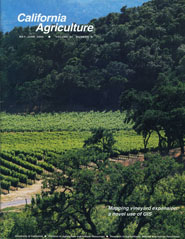


University of California
California Agriculture



|
|||
|
|||

Mapping vineyard expansion: a novel use of GIS
Cover:
With economic boom times, statewide wine grape acreage has increased 53% since 1990. Scientists have examined growth in Sonoma County (see pp 4-20). - Photo by Jack kelly Clark
May-June 2000
Volume 54, Number 3 |
|||
|
University of California, 1301 S. 46th St., Bldg. 478 Richmond, CA
|